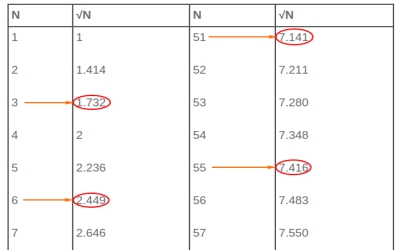Square roots table
Below is a square roots table that can be used as a quick reference to check the square root of numbers from 1 through 100. It may be obvious yet see below how you can use the table to find the square root of a number.| N | √N | N | √N |
|
1 2 3 4 5 6 7 8 9 10 11 12 13 14 15 16 17 18 19 20 21 22 23 24 25 26 27 28 29 30 31 32 33 34 35 36 37 38 39 40 41 42 43 44 45 46 47 48 49 50 |
1 1.414 1.732 2 2.236 2.449 2.646 2.828 3 3.162 3.317 3.464 3.606 3.742 3.873 4 4.123 4.243 4.359 4.472 4.583 4.690 4.796 4.899 5 5.099 5.196 5.292 5.385 5.477 5.568 5.657 5.745 5.831 5.916 6 6.083 6.164 6.245 6.325 6.403 6.481 6.557 6.633 6.708 6.782 6.856 6.928 7 7.071 |
51 52 53 54 55 56 57 58 59 60 61 62 63 64 65 66 67 68 69 70 71 72 73 74 75 76 77 78 79 80 81 82 83 84 85 86 87 88 89 90 91 92 93 94 95 96 97 98 99 100 |
7.141 7.211 7.280 7.348 7.416 7.483 7.550 7.616 7.681 7.746 7.810 7.874 7.937 8 8.062 8.124 8.185 8.246 8.307 8.367 8.426 8.485 8.544 8.602 8.660 8.718 8.775 8.832 8.888 8.944 9 9.055 9.110 9.165 9.220 9.274 9.327 9.381 9.434 9.487 9.539 9.592 9.644 9.695 9.747 9.798 9.849 9.899 9.950 10 |
How to read the square roots table to find the square root.

Above, we have copied a portion of the square roots table. From the table, you can clearly see the following square roots.
- The square root of 3 is 1.732
- The square root of 6 is 2.449
- The square root of 51 is 7.141
- The square root of 55 is 7.416
- The square root of 7 is 2.646
- The square root of 53 is 7.280
- The square root of 4 is 2
- The square root of 78 is 8.832
- The square root of 31 is 5.568
A brief review on what the square root of a number is.
The product of two identical numbers is another number. One of the two identical numbers is the square root of the other number.
For example, the product of 11 and 11 is another number or 121.
11 is the square root of 121.